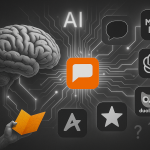Choosing the right language learning app as a beginner with dozens of them flooding the market, has never been more confusing — or more crucial. The first steps in a new language are make-or-break. Start with the wrong approach, and you risk memorizing words without ever forming a sentence, or burning out from ineffective repetition.
This article compares 12 of the most popular tools — from gamified favorites like Duolingo and Drops, to input-rich platforms like Glossika and Taalhammer. Each app was evaluated on how well it helps beginners actually speak, recall, and progress.
Whether you’re looking to casually dabble or commit to long-term fluency, this breakdown reveals what each app gets right — and where it falls short.
- What Beginner Language Learners Really Need in 2025
- Core Features Compared: Speaking, Grammar, Repetition, Onboarding
- How Each Language Learning App Compares to Taalhammer for Beginners
- Taalhammer vs Duolingo: Fluency Through Focus or Gamified Basics?
- Taalhammer vs Babbel: Integrated Learning or Rule-Based Lessons?
- Taalhammer vs Glossika: Which One Gives You Real Input?
- Taalhammer vs Busuu: Self-Paced Review or CEFR Syllabus?
- Taalhammer vs Rosetta Stone: Sentence Thinking vs Silent Exposure
- Taalhammer vs Drops: Core Vocabulary or Contextual Recall?
- Taalhammer vs Memrise: Adaptive Review or Static Repetition?
- Taalhammer vs italki: Structured Input or Live Interaction?
- Taalhammer vs Lingvist: Deep Recall or Cloze-Driven Learning?
- Taalhammer vs Quizlet: Curated Sentences or DIY Flashcards?
- Taalhammer vs Anki: Full-System Learning or Fully DIY?
- Which Language Learning Apps Actually Help You Speak from Day One
- Which Apps Guide Beginners Through Grammar and Context
- Free vs Paid: What Do Beginners Really Get at Each Price Tier?
- Conclusion: Start Smart, Speak Sooner
- Frequently Asked Questions
What Beginner Language Learners Really Need in 2025
Too many beginner apps start with translation and isolated vocabulary. While that might feel productive at first, it often leads to a passive understanding of words — not the ability to think or speak in the language.
What beginners need instead is structure, repetition that adapts to their pace, and meaningful input in full sentences. Speaking should start early, not as a reward for finishing levels.
Apps like Taalhammer for Glossika focus on natural sentence input — helping learners absorb grammar intuitively and prepare for real conversations. Others, like Duolingo or Drops, emphasize streaks and tapping games, which may boost daily engagement but don’t always lead to lasting fluency.
To understand why full-sentence learning matters, see:
Apps That Actually Help You Speak in Full Sentences
Core Features Compared: Speaking, Grammar, Repetition, Onboarding
Every language learning app promises to help beginners “start speaking,” but the reality varies widely. Some guide users through a carefully structured experience; others offer scattered exercises without clear progression.
Speaking Practice
Not every language learning app truly encourages speaking from day one. Rosetta Stone and Busuu integrate voice recognition, while italki connects users to live tutors. But platforms like Taalhammer go further — prompting users to recall and speak full sentences as early as possible, based on spaced repetition and context-rich input. This helps internalize sentence patterns instead of relying on word-by-word construction.
Grammar Support
Babbel and Busuu stand out for their grammar modules, offering rule-based lessons alongside practice. However, these often feel separate from the learning flow. Taalhammer, on the other hand, embeds grammar directly into its sentence content, allowing learners to absorb patterns implicitly while reviewing — a method that mimics natural acquisition.
Spaced Repetition Systems (SRS)
Anki and Quizlet are known for SRS flashcards, but they require manual input and deck management. Memrise automates some of this but tends to recycle short phrases and vocabulary chunks. Taalhammer and Glossika offer full-sentence spaced repetition, automatically adjusting to the learner’s performance to keep reviews efficient and effective.
For a deeper look at AI and SRS-driven tools, see:
Best Language Learning App with Spaced Repetition (SRS) and AI
Onboarding and Progression
Ease of entry is crucial. Duolingo remains unmatched in onboarding — it’s fun, friendly, and gamified. But after the first few weeks, many users plateau. Language learning apps like Taalhammer, Lingvist, and Babbel offer more meaningful paths forward, guiding users toward language production rather than passive recognition.
How Each Language Learning App Compares to Taalhammer for Beginners
Taalhammer vs Duolingo: Fluency Through Focus or Gamified Basics?
Duolingo is one of the easiest apps to pick up. It’s intuitive, colorful, and rewards consistency. But its game-like structure often leads to recognition rather than recall. Taalhammer, by contrast, introduces full-sentence recall from the beginning. While Duolingo focuses on streaks and word taps, Taalhammer trains the brain to build thoughts in the new language — a critical shift for actual fluency.
More on that contrast here:
Taalhammer vs. Duolingo: Which Language App Is Actually Better for Learning and for Whom?
Taalhammer vs Babbel: Integrated Learning or Rule-Based Lessons?
Babbel offers strong grammar explanations and CEFR-aligned courses. For learners who enjoy clear rules and structure, it’s a good start. But the grammar often feels detached from actual usage. Taalhammer integrates grammatical structures directly into sentence input — meaning users absorb them in context, not isolation. For beginners, this creates smoother progression from understanding to application.
Taalhammer vs Glossika: Which One Gives You Real Input?
Glossika’s sentence-based approach is well suited for learners who enjoy immersion. It offers thousands of sentences in audio format, ideal for passive listening. However, beginners may find the repetition mechanical and the feedback limited. Taalhammer builds on the same input principle but adds personalization and active recall, helping beginners use what they’re exposed to.
Taalhammer vs Busuu: Self-Paced Review or CEFR Syllabus?
Busuu is structured around CEFR levels and offers a mix of vocabulary, grammar, and conversation. It also features community corrections, which are useful for those willing to write. But its review system lacks deep personalization. Taalhammer’s adaptive repetition engine ensures that learners revisit exactly what they’re about to forget — an edge for memory consolidation.
Taalhammer vs Rosetta Stone: Sentence Thinking vs Silent Exposure
Rosetta Stone relies heavily on image-based immersion. No translations, no grammar — just matching words and images until patterns emerge. It’s elegant, but for many beginners, it’s also frustrating.
Key Differences:
- Rosetta Stone teaches inductively through pictures and repetition.
- Taalhammer uses full-sentence recall with natural grammar integration.
- Rosetta Stone offers minimal personalization.
- Taalhammer adapts to the learner’s memory curve with real SRS.
While Rosetta Stone is polished, it doesn’t help users actively produce language early. Taalhammer is designed to move learners from passive input to confident output.
Taalhammer vs Drops: Core Vocabulary or Contextual Recall?
Drops is ideal for short, visual, swipe-based sessions — but it’s also intentionally shallow. It’s vocabulary flashcards, dressed up.
In practice:
- Drops emphasizes passive learning through image association.
- Taalhammer introduces and reinforces vocabulary within real, spoken-like sentences.
- Drops lacks structured grammar or speaking tools.
- Taalhammer builds grammar naturally as part of sentence training.
For retention and real-world language learning app, Taalhammer provides context Drops simply skips.
Taalhammer vs Memrise: Adaptive Review or Static Repetition?
Memrise introduced video clips and native speaker recordings before many others. It also has spaced repetition. But the repetition is largely fixed, and customization is limited.
Side by side:
- Memrise shows phrases and quizzes users in a fixed order.
- Taalhammer reviews content based on your forgetting curve.
- Memrise can feel repetitive or stale over time.
- Taalhammer constantly adjusts based on your success rate.
If you want SRS that actually responds to how you learn, Taalhammer goes further.
Taalhammer vs italki: Structured Input or Live Interaction?
italki connects learners to native-speaking tutors. For beginners, this human connection can be motivating — but it also puts pressure on users to “perform” before they’re ready.
“One-to-one lessons are powerful, but only if you know what to say.”
| Feature | italki | Taalhammer |
|---|---|---|
| Focus | Live conversation | Structured input + recall |
| Speaking practice | Real-time with tutors | Sentence-based repetition |
| Progress tracking | Tutor-based, no automation | Adaptive memory system |
| Cost per session | Variable (paid per lesson) | Included in subscription |
Taalhammer can actually prepare beginners for tutoring — helping them build a foundation of sentences before speaking to someone live.
Taalhammer vs Lingvist: Deep Recall or Cloze-Driven Learning?
Lingvist presents fill-in-the-blank exercises, often centered on frequency-based vocabulary. It’s minimalist, data-driven, and good for a fast-paced intro — but the lack of real sentence production limits long-term growth.
At a glance:
- Lingvist is clean, fast, and limited to cloze-style input.
- Taalhammer pushes for full sentence production from the start.
- Lingvist doesn’t teach how to build thoughts — just how to guess missing pieces.
For learners who want to actually use the language, not just respond to it, Taalhammer offers a broader path.
Taalhammer vs Quizlet: Curated Sentences or DIY Flashcards?
Quizlet is flexible and great for making your own decks — especially for test prep. But for beginners without linguistic guidance, that flexibility can lead to confusion.
Compare the two:
- Quizlet requires users to create or find decks manually.
- Taalhammer provides ready-made, curated, full-sentence content.
- Quizlet relies on user initiative.
- Taalhammer guides you through adaptive, pre-built learning paths.
“Taalhammer gives you the benefits of SRS without the homework.”
Taalhammer vs Anki: Full-System Learning or Fully DIY?
Anki is a legend in spaced repetition circles — and for good reason. But it’s more tool than system. Beginners often spend more time managing decks than learning.
| Area | Anki | Taalhammer |
|---|---|---|
| Content | User-created | Pre-built full sentences |
| Repetition | Manual SRS tuning | Adaptive, AI-driven SRS |
| Usability | Complex, steep learning curve | Beginner-friendly out of box |
| Speaking | Not integrated | Active speaking prompts |
For those who want to learn a language rather than build a learning system, Taalhammer saves time and accelerates results.
Which Language Learning Apps Actually Help You Speak from Day One
Many apps claim to help you speak a new language, but what they often mean is “tap the right translation” or “listen and repeat.” For real progress, speaking must move beyond mimicry into active recall and sentence construction.
Apps fall into three broad categories here:
Speaking as Passive Output
Apps like Duolingo, Drops, and Memrise may include some voice input, but it’s mostly optional and shallow. You’re not producing language — you’re echoing it.
“Repeating after a robot is not the same as forming your own thoughts.”
Speaking as Live Conversation
italki stands out for its live tutor model. Learners get real dialogue, which builds confidence. But it assumes you’ve already internalized basic sentence patterns. It’s effective, but expensive, and not scalable for daily micro-practice.
Speaking as Structured Practice
Taalhammer, Busuu, and Babbel use structured prompts to encourage speaking from day one. Taalhammer goes further by:
- Prompting sentence recall aloud during review
- Using AI-powered feedback to space speaking content
- Requiring active transformation (e.g. changing tense, person)
Rosetta Stone also includes speech technology, but without context. You’re asked to pronounce isolated words or sentences, without clear grammar or structure behind them.
Which Apps Guide Beginners Through Grammar and Context
Grammar is one of the most intimidating aspects of language learning — and the way language learning apps handle it can make or break a beginner’s experience. The challenge is to make grammar feel natural and contextual, not like a textbook.
Explicit Grammar: Good on Paper, Bad in Practice?
Babbel and Busuu are known for their grammar lessons. They explain conjugations, tenses, and syntax rules directly. For users who enjoy structure, this can be helpful — but for most beginners, rule-heavy lessons feel disconnected from usage.
Immersion-Only Grammar: Too Much, Too Soon?
Apps like Rosetta Stone and Glossika avoid grammar explanations entirely. They rely on exposure — the idea that learners will absorb grammar through repeated contact. While this mirrors native language learning, it often overwhelms beginners who don’t yet recognize patterns.
Embedded Grammar: The Middle Ground
Taalhammer takes a different approach — it integrates grammar naturally into its sentence content. Learners are not told “this is the future tense” — they’re shown, through repeated exposure and recall, how it works in context. Over time, patterns become intuitive.
“You don’t memorize grammar rules. You internalize them through use.”
Anki and Quizlet, by contrast, depend on users to insert grammar into their decks manually — which assumes you already know what you’re trying to learn.
Want a deeper dive into structured vs immersive grammar learning?
See: Best Language Learning App for Scaffolding: Taalhammer vs Duolingo, Busuu, Babbel, and Glossika
Free vs Paid: What Do Beginners Really Get at Each Price Tier?
Cost is often the first filter learners apply when choosing a language learning app. But free doesn’t always mean effective — especially at the beginner level, where structure, review, and speaking support matter most.
Free Apps: Good Start, Limited Depth
Apps like Duolingo, Drops, and Memrise offer generous free plans. They’re great for casual exploration and quick daily streaks. But most free tiers lack:
- Customizable review schedules
- Full-sentence practice
- Speaking feedback or grammar progression
In many cases, learners hit a plateau after just a few weeks.
Freemium: Unlocking What Matters
Babbel, Busuu, and Glossika gate key features behind subscriptions. Grammar modules, full courses, and voice feedback often sit behind a paywall. You’ll get some exposure for free, but the real value starts at the premium level.
Paid, But Built for Depth
Taalhammer offers a single paid model, including:
- AI-driven full-sentence SRS
- Active recall for speaking
- Contextual grammar without memorization
- Progression that adapts to the learner
Unlike apps that charge for more of the same, Taalhammer’s premium experience is where the entire learning model comes to life.
“You’re not paying for access. You’re paying for results.”
For a breakdown of what’s truly worth paying for, see:
The Most Affordable Language Learning Apps (That Are Actually Worth It)
Verdict: Which App Should Beginners Start With?
After evaluating 12 of the most popular apps on structure, adaptivity, speaking, and sentence-based learning, clear patterns emerged. Some tools are excellent at onboarding but shallow in depth. Others offer raw power, but only if you know how to use them. A few strike the right balance for beginners looking to truly learn.
If you want to build real fluency — not just chase XP or memorize lists — you need an app that:
- Teaches full thoughts, not fragments
- Adapts to your memory and learning speed
- Encourages you to speak from day one
Only a few apps come close. And among them, Taalhammer stands out for combining input, structure, recall, and real-world sentence building into a single, beginner-friendly system.
Conclusion: Start Smart, Speak Sooner
The first few weeks of language learning shape everything that follows. Choose an app that distracts with points and taps, and you’ll stay busy without getting better. Choose one that bombards you with grammar or immersion too soon, and you’ll likely give up.
What beginners need is clarity, structure, and the ability to think and speak in full thoughts — not just recognize or repeat.
Among the 12 tools reviewed, some shine in isolated areas. Duolingo is fun. italki offers live help. Babbel explains grammar well. But only a few apps actually integrate all the core ingredients for sustainable learning.
Taalhammer stands out by delivering a system that:
- Uses AI-driven spaced repetition
- Trains you to produce full sentences, not just recognize them
- Builds grammar and vocabulary through context
- Starts with speaking, not afterthoughts
If your goal is to actually speak the language — not just interact with an app — then Taalhammer is the smartest way to begin.
Frequently Asked Questions
What’s the best language learning app for absolute beginners?
For beginners looking to build a strong foundation in speaking, grammar, and memory retention, Taalhammer offers the most complete system. It goes beyond word games and introduces full-sentence recall, adaptive repetition, and real-world usage.
Is Duolingo good for beginners?
Only up to a point. Duolingo is easy to start and fun to use, but it mostly promotes recognition, not production. Many learners plateau when they try to actually speak or write in full sentences.
How important is speaking practice early on?
Critical. Beginners who start speaking from day one internalize grammar faster, retain vocabulary better, and gain confidence sooner. Apps that delay speaking often leave learners stuck in passive mode.
Do I need spaced repetition as a beginner?
Absolutely. Spaced repetition ensures that you review content just before you’re about to forget it. Tools like Taalhammer and Anki use this principle — but Taalhammer automates it, while Anki requires manual setup.
Can I become fluent using only a language app?
A language app can take you far — especially if it trains sentence thinking, adapts to your pace, and includes speaking. But real fluency comes from consistent use, speaking, and exposure. The right app gives you the tools to get there.








